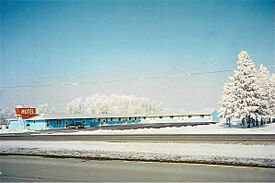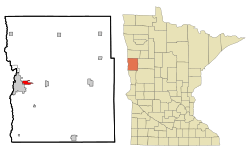Dilworth, Minnesota facts for kids
Quick facts for kids
Dilworth, Minnesota
|
||
|---|---|---|

Star Lite Motel
|
||
|
||
| Nickname(s):
D-town
|
||

Location of Dilworth in Clay County, Minnesota
|
||
| Country | United States | |
| State | Minnesota | |
| County | Clay | |
| Founded | 1883 | |
| Incorporated | August 17, 1911 | |
| Government | ||
| • Type | Mayor-Council | |
| Area | ||
| • City | 3.464 sq mi (8.972 km2) | |
| • Land | 3.461 sq mi (8.963 km2) | |
| • Water | 0.003 sq mi (0.007 km2) | |
| Elevation | 909 ft (277 m) | |
| Population
(2020)
|
||
| • City | 4,612 | |
| • Estimate
(2023)
|
4,772 | |
| • Density | 1,483.03/sq mi (572.60/km2) | |
| • Urban | 216,214 | |
| • Metro | 262,620 | |
| Time zone | UTC−6 (Central) | |
| • Summer (DST) | UTC−5 (CDT) | |
| ZIP Code |
56529
|
|
| Area code(s) | 218 | |
| FIPS code | 27-15976 | |
| GNIS feature ID | 2394536 | |
| Sales tax | 7.375% | |
Dilworth is a city in Clay County, Minnesota, United States. It had a population of 4,612 people in 2020. Dilworth is part of the larger Fargo–Moorhead area. It is located right next to Moorhead. Dilworth is known for the old Star Lite Motel and the Dilworth Rail Yard. This rail yard is one of the biggest and busiest train facilities for BNSF Railway in Minnesota.
Contents
History of Dilworth
Dilworth started in 1883. It was founded when the Northern Pacific Railroad built tracks to this spot. The city was named after Joseph Dilworth, who was a railroad official.
The area was first called Richardson. The Northern Pacific Railroad set up a station here in 1883. In November 1884, its name changed to Dilworth. This was to honor Joseph Dilworth from Pittsburgh, Pennsylvania. He was a coffee importer and a director for the Northern Pacific Railroad.
Until 1906, Dilworth was a small train stop. It had a side track for two grain elevators. There was no train station building or agent. The main railroad sites in Fargo became too crowded. So, Dilworth was chosen for a new, larger train facility. By July 1906, the Northern Pacific bought almost 500 acres of land around Dilworth. This was for their new main operations.
A big part of the new facility was the roundhouse. This was a huge building shaped like a donut with a missing piece. In the middle of the "donut hole" was a turntable. This was like a giant spinning tray. A train engine would drive onto the turntable. The turntable would then spin the engine towards one of 45 stalls. In these stalls, engines were fixed and prepared. Then, the engine would back out onto the turntable. It would spin again to pull another train in a different direction.
The village grew very quickly. In mid-1907, it had almost no people. By spring 1910, nearly 500 people lived there. The railroad needed a hotel to house its workers. This was until the town could grow and workers could find their own homes.
In 1911, Dilworth officially became a village. It set up its own government and police. F. C. Alsop was the first Mayor of Dilworth. Christian Haugsted was the Clerk. In 1918, J. M. Manning became Mayor. O. Wirud was Clerk. M. J. Peirsol was in charge of streets. L. G. Hanson was the Treasurer.
The Dilworth Fire Department started in 1911. By 1928, its equipment was worth about $1,000. It had two extension ladders, two hose carts, and 18 volunteer firefighters.
Dilworth's fast growth also made its school system busy. Clay County approved School District 81 on March 3, 1896. This area had eight school-aged children. In 1905, District 81 built a new one-room school. By 1908, the school had 93 students! The District then built a much bigger school.
One of the first churches in Dilworth was the Presbyterian Church. It started building on May 15, 1907. The church's ladies' group raised money with bake sales and social events. When the church opened on August 11, it had no debt. This church is still standing today. It is probably the oldest building in Dilworth.
St. Elizabeth’s Catholic Church took longer to start. In 1907, a priest from Moorhead visited Dilworth. He wanted to see if Catholics in Dilworth wanted to form a church. It took a few years, but in July 1910, new efforts began. Less than two months later, the community built a new concrete block church. It was used until the current church was built in 1964.
Businesses quickly opened in the summer of 1907. A lumber company opened a yard in late July. A few days later, Olaus Anderson opened a general store. Rasmus Haugsted opened another general store soon after. In mid-August, Haugsted became Dilworth’s first Post Master. He ran the Post Office from his store. By 1910, Dilworth had a bank, two hotels, a grocery store, a dairy, a meat market, a bakery, at least two restaurants, and a barbershop. About 498 people lived in Dilworth. Nearly 70% of them worked for the railroad.
Dilworth was often called Little Italy. This was because many Italian immigrants settled there.
Geography
Dilworth covers about 3.46 square miles (8.97 square kilometers). Most of this area is land. Only a tiny part is water.
Population and People
| Historical population | |||
|---|---|---|---|
| Census | Pop. | %± | |
| 1920 | 882 | — | |
| 1930 | 983 | 11.5% | |
| 1940 | 1,068 | 8.6% | |
| 1950 | 1,429 | 33.8% | |
| 1960 | 2,102 | 47.1% | |
| 1970 | 2,321 | 10.4% | |
| 1980 | 2,585 | 11.4% | |
| 1990 | 2,562 | −0.9% | |
| 2000 | 3,001 | 17.1% | |
| 2010 | 4,024 | 34.1% | |
| 2020 | 4,612 | 14.6% | |
| 2023 (est.) | 4,772 | 18.6% | |
| U.S. Decennial Census 2020 Census |
|||
In 2022, Dilworth had about 1,889 households. Each household had about 2.4 people on average. The average income for a household was about $84,602. About 10% of the people in Dilworth live below the poverty line. This means their income is below a certain level. About 74.2% of people in Dilworth have jobs. Most adults (94.6%) have a high school diploma. About 39% have a college degree or higher.
The main backgrounds people reported were English (88.7%). Other backgrounds included Spanish (3.1%), and other European groups (2.3%). Asian and Pacific Islander groups made up 0.8%.
The average age of people in Dilworth was 39.3 years old.
2020 Census Details
| Race / ethnicity (NH = non-Hispanic) | Pop. 2000 | Pop. 2010 | Pop. 2020 | % 2000 | % 2010 | % 2020 |
|---|---|---|---|---|---|---|
| White alone (NH) | 2,670 | 3,606 | 3,877 | 88.97% | 89.61% | 84.06% |
| Black or African American alone (NH) | 1 | 18 | 156 | 0.03% | 0.45% | 3.38% |
| Native American or Alaska Native alone (NH) | 47 | 79 | 69 | 1.57% | 1.96% | 1.50% |
| Asian alone (NH) | 6 | 33 | 23 | 0.20% | 0.82% | 0.50% |
| Pacific Islander alone (NH) | 0 | 0 | 0 | 0.00% | 0.00% | 0.00% |
| Other race alone (NH) | 0 | 0 | 14 | 0.00% | 0.00% | 0.30% |
| Mixed race or multiracial (NH) | 48 | 59 | 212 | 1.60% | 1.47% | 4.60% |
| Hispanic or Latino (any race) | 229 | 229 | 261 | 7.63% | 5.69% | 5.66% |
| Total | 3,001 | 4,024 | 4,612 | 100.00% | 100.00% | 100.00% |
In 2020, Dilworth had 4,612 people living there. There were 1,828 households and 1,213 families. The city had about 1,437 people per square mile. Most people (85.95%) were White. Other groups included African American (3.40%), Native American (1.93%), and Asian (0.50%). About 5.66% of the population was Hispanic or Latino. About 23.9% of residents were under 18 years old. About 12.2% were 65 or older.
2010 Census Details
In 2010, Dilworth had 4,024 people. There were 1,595 households and 1,053 families. The population density was about 1,216 people per square mile. Most people (93.29%) were White. Other groups included African American (0.47%), Native American (2.14%), and Asian (0.84%). About 5.69% of the population was Hispanic or Latino.
About 36.2% of households had children under 18. About 51% were married couples. About 28.3% of households were single people living alone. The average household had 2.52 people.
The average age in the city was 34.3 years. About 28.7% of people were under 18. About 11.7% were 65 or older. The number of males and females was almost equal.
Economy
Dilworth has several important employers. These companies provide many jobs for the city's residents.
| # | Employer | What they do | Number of Employees |
|---|---|---|---|
| 1 | Burlington Northern/Santa Fe Railroad | Train transportation | 375 |
| 2 | Walmart | Department store | 225 |
| 3 | Dilworth Public Schools | Elementary and high schools | 95 |
| 4 | FM Asphalt LLC. | Makes petroleum and coal products | 85 |
| 5 | Slumberland | Sells furniture | 30 |
Transportation
Dilworth is connected to nearby Moorhead and Fargo by MATBUS. This is a public bus system.
U.S. Route 10, also called Highway 10, is a main road in the city. Interstate 94 is also nearby. You can reach it from Highway 10 using Minnesota State Highway 336.
The Empire Builder train, run by Amtrak, goes through Dilworth. This train travels between Seattle/Portland and Chicago. However, it does not stop in Dilworth. The closest train station is in Fargo, about 4 miles (6.4 km) to the west.
Churches
Roman Catholic
- St. Elizabeth Catholic Church
Evangelical Lutheran in America
- Dilworth Lutheran Church
Presbyterian
- First Presbyterian Bible Church of Dilworth
Assemblies of God
- River Valley Church
See also
 In Spanish: Dilworth (Minnesota) para niños
In Spanish: Dilworth (Minnesota) para niños


